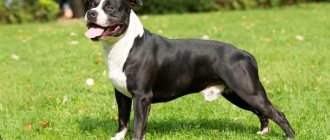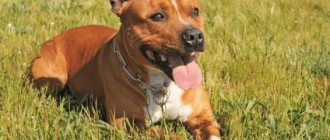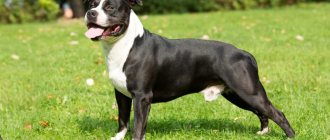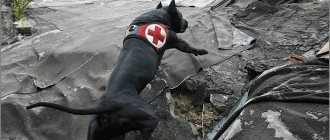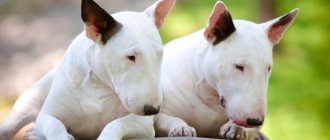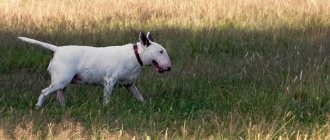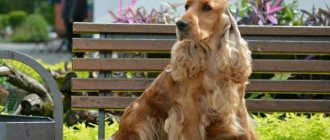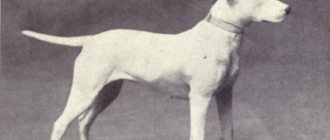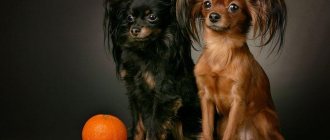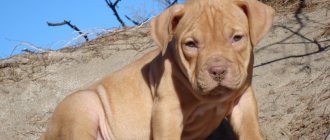Dog breeds for comparison:
- Bull Terrier (standard or miniature)
- English (SBT) - aka Staffbull or Staffy
- American Pit Bull Terrier (APBT) - aka pit bull
- American Staffordshire Terrier (AST) - also known as Staff, Amstaff, Stafford
The Staffordshire bull terrier, Staffordshire terrier, pit bull and bull terrier have common ancestors - bulldogs (English bulldog, literally: “bull dog”), which at the beginning of the 19th century were used for brutal baiting of bulls and bears in England.
Despite their historical relationship, these dogs were bred for different purposes and have certain external differences. These breeds received official recognition at approximately the same time - in the second half of the 19th century. Some of them are even registered twice: for example, the same breed was presented in England as the American Pit Bull Terrier, and in America as the American Staffordshire Terrier. There is a similar confusion with the Stafford: this is what the English Staffordshire Bull Terrier is called all over the world, and here we call it Amstafa.
To understand in more detail the differences between the Staffordshire Terrier (Amstaff), the American Pit Bull Terrier (Pit Bull), the Staffordshire Bull Terrier (Staff Bull) and the Standard Bull Terrier, let's look at each breed separately.
What is the difference between a Staff Bull and a Staffordshire Terrier, Pit Bull and Bull Terrier?
The English Staffordshire Bull Terrier is distinguished from other breeds by its highly developed cheek muscles and wide skull. Because of these features of the structure of the muzzle, he was nicknamed the smiling dog.
Having a common ancestor, the Staffordshire Bull Terrier, American Pit Bull, Staffordshire Terrier and Bull Terrier were bred for one purpose - these dogs were intended for fighting. The only difference was in specialization: baiting bulls, bears, or fighting with their own tribesmen. Therefore, it is impossible to determine which of the listed breeds is more dangerous.
A dog's behavior primarily depends on proper upbringing and socialization. If you do not devote enough time to this, or make systematic mistakes (for example, mistreating your pet), then a dog of any breed, even a decorative one, can become aggressive.
There are often some similarities in character and appearance among different dog breeds.
One such pair is pit bull terriers and Staffordshire terriers, which are often confused or believed to be the same breed.
The similarity between pit bulls and staff dogs is understandable - they were bred for the same purpose and from the same dogs, in particular the Staffordshire bull terrier.
So how are they different?
Pit bull terriers
Pit bull terriers are a popular and well-known breed of dog, bred by English breeders to participate in dog fighting.
Photo and description
Pit bulls are medium-sized dogs. They have a strong, muscular body, and their overall figure looks athletic and fit. The appearance of representatives of this breed amazingly combines barely restrained strength, power and incredible grace, dexterity and mobility.
Pitbull has:
- rectangular head of medium length;
- wide and deep square muzzle;
- scissor bite;
- medium-sized eyes that may be almond-shaped, elliptical or round in shape;
- small semi-drop ears;
- powerful and strong back;
- short, strong and slightly convex loin;
- low set tail of medium length.
Pit bull terriers have a short, hard, close-fitting coat with no undercoat, which can be of almost any color except merle. The most popular colors are black and gray.
Advantages and disadvantages
Speaking about the advantages of pit bulls, it should be noted that they:
- do not require labor-intensive care;
- smart;
- trainable;
- loyal;
- hardy;
- friendly;
- get along with children;
- sociable.
The disadvantages of representatives of this breed include:
- the need for early socialization and proper education;
- a tendency to lead both in the family and in contact with other animals, which provokes an aggressive attitude towards pit bulls towards the latter;
- the inability to be alone and the need for constant contact with the owner.
Pit bulls are also stubborn and willful; not everyone can cope with their difficult character.
Character
Pit bulls, despite the popular opinion about them, are distinguished by their friendly, affectionate and playful character. They are incredibly loyal to their owner and become his companions, companions and true friends.
Being strong and fearless, these dogs do not hesitate to defend their owner and his family if they are in danger.
Pit bull terriers are smart and their training is quite easy, since representatives of this breed memorize commands quickly. Problems can arise only because of their inherent stubbornness, willfulness and habit of making decisions on their own.
It is important that the owner indicates to the puppy as early as possible that he is not a leader, begins his socialization and training, and also shows patience, perseverance and strength of character.
Description of the character of the pit bull terrier
Staff and pit bull are considered dangerous breeds. What they are not prescribed: killer dogs, cannibals, fighting dogs.
There is no concept of “fighting dog” in cynology. This is a human invention. And the owners are to blame for the cruelty of the staff.
- More aggressive. Pit bulls were used for dog fighting. Most likely, this is what gave rise to the name “fighting dog.” This cruel sport is still attractive in some countries. And representatives of this species are its main participants;
- The pit bull terrier is distinguished from the staff by its endurance. A dog can hold out for up to three hours, fighting with other dogs;
- Stubbornness. The pet needs a strong master's hand. This does not mean that the dog should be beaten and raised using cruel methods. On the contrary, mechanical impacts on it will lead to dire consequences. Raise a representative of the breed only on the positive;
- Aggression towards other animals. A pit bull terrier and a cat are not compatible in the same territory. An exception can only be when a very small puppy was brought to an adult cat, and she took an active part in his upbringing. It is not recommended to bring a kitten into an apartment where a pit bull lives. The dog will kill him. Representatives of the breed do not like rodents either. Pit bulls were bred not only for protection, but also for hunting. They know how to kill rats.
We invite you to familiarize yourself with: Welsh Terrier – photo, breed characteristics, puppy price
- The Staffordshire Terrier is more docile. If his “brother” is lazy and tries with all his might to prove his superiority over the owner, then the Amstaff loves to learn. He is dominant and will happily “sit on your neck” if allowed. Having no respect for the owner, he is able to ignore his commands. The dog enjoys the learning process itself. At this moment it becomes a model of obedience.
- Loves children. This love takes on an all-encompassing form. Give amstaff free rein, he will not part with the child. He will protect him, accompany him everywhere, invite him to play together. Such friendliness is very touching. But no matter how sweet and kind a pet is, it is a dog. And he is capable, without meaning to, of injuring a child.
- Quite a cunning animal. If a pit bull terrier is prohibited from doing something, he will not try to circumvent the prohibition. Staffordshire will work hard to achieve this.
- Lover of outdoor games. A dog that looks like a wind-up toy will delight active people. Don't feed your staff bread - give him the opportunity to play and run. Will be happy to take part in a long walk.
Home » Dog breeds » American Staffordshire Terrier dog, difference between Amstaff and Pitbull, photo
Courageous and uniquely intelligent, American Staffordshire Terriers require experienced owners with a strong character. This is the only way to raise a puppy into a reliable and devoted protector - by suppressing any expression of unfriendly behavior. A well-mannered, obedient Amstaff is a sign of its owner’s aerobatics in training.
Content
• terriers have longer legs; • their chest is wider; • muscular body; • the difference in height reaches 6 cm, in weight – up to 8 kg; • nose and claws are always black.
The more significant differences between the Amstaff and Pitbull are in character. Both breeds were originally intended for rough sports, but in a fight he would rather lose than win, despite being larger. The pit bull has a lower threshold for pain sensitivity and is more ferocious and persistent. This mattered when dog fights were happening everywhere.
In the 30s of the last century in America and England, Amstaffs were registered in registries, and pit bulls were identified as an independent species.
Description of the breed
The official name of the breed is American Staffordshire Terrier. There are other abbreviated names - Stafford, Amstaff. The description of the dog contains the words: “infinitely brave, courageous, friendly, keenly interested in others.” The standard establishes the requirement that aggression towards a person is inadmissible.
Shih Tzu breed, description and photo of the imperial dog
The Staffordshire Terrier dog is prone to improvisation. This is manifested in the study of everything that surrounds her. She's smart. Sometimes an American Stafford needs just one glance or a nod from the owner to guess his desire.
Description of the standard
• Strong stocky body with prominent muscles, well-developed bones and slightly stretched. • Wide head with a square skull and a clear stop from the forehead to the muzzle. • Convex muzzle with dense lips, black nose, open nostrils. • Strong jaws, almost square in shape. • The eyes are dark with black eyelids.
The description of the Staffordshire Terrier mentions dry lips and eyes, which is an attractive feature in this breed, related to bulldogs. In practice, this means the absence of excessive drooling, which interferes with close communication and is the cause of stains on carpets, floors and furniture when kept at home.
Looking at a selection of photos of Staffordshire Terriers, one can note the variety of colors of the short, coarse coat. Amstaphs can be one-color, part-color, spotted, striped, two-color, with tan. Shades of gray on black are called blue; fawn, sand, and red colors look impressive. White spots are acceptable, occupying up to 20% of the terrier's skin.
The aura of the Amstaff dog being a fighting breed supports the myth of its aggressiveness. But in reality, only in isolated cases does it fail to socialize an animal. The character of the Staffordshire Terrier is transformed if, from infancy, you raise it in an atmosphere of friendliness, strictly instilling obedience, and stopping the puppy from trying to dominate even during play.
The dog's devotion is such that if it decides that the household members are in danger, it may overdo it in protecting them. It is worth keeping this in mind and insuring yourself: keep the animal on a leash, muzzled, monitor the intonation and strength of the voice when strangers and animals are nearby. Trying to please the owner, the Stafford will follow his instinct.
Basenji: non-barking dog of African breeds, description of advantages and character
The Amstaff is very smart, understands perfectly, and therefore lends itself well to training, which is mandatory and must be constant. The training process will be successful if the owner shows a strong character, given that the breed does not tolerate physical pressure and injustice, which it subtly senses. The contact may be broken, the dog will demonstratively “forget” the learned commands. To ensure the safety of children, they should not be left alone with the animal unattended.
Health and care
The positive characteristics of the Staffordshire Terrier breed include its good health, which is not susceptible to genetic diseases. Throughout their life of 12-15 years, animals remain active. And only with age can American Terriers develop dysplasia, deafness, arthritis, cataracts, and cancer.
https://www.youtube.com/video/yjm06YEZstk
Amstaff dogs should absolutely not be kept on a leash. The best conditions for these medium-sized dogs are an apartment where they feel quite comfortable, or a country house. For mental health and staying fit, they need companionship and long 2-hour walks twice a day.
The breed's short-haired characteristics make it much easier to care for the American Terrier's fur, which involves brushing it with a stiff brush. You can wash your dog often: she loves water. Cleanliness is maintained in an alternative way using dry shampoo. After the procedures, the wool is wiped with suede, which gives it shine.
An adult dog should be fed twice a day, avoiding salty, fatty, sweet, and smoked foods. Food is excluded from the hosts' table. The food can be ready-made - dry, wet, the quality is not lower than premium. It is acceptable to alternate with natural foods - beef, lamb, boiled offal and fish, porridges made from low-starch cereals: corn, buckwheat, oatmeal, wheat.
A wonderful companion, devoted friend and protector is the Staffordshire Terrier. A photo of his face with a wide smile and the penetrating gaze of his intelligent eyes will definitely be pasted into the family album, imprinted in the soul and heart of his loving owners - we are sure of this.
The pit bull terrier is very attached to children, and the pit bull terrier’s low sensitivity threshold makes it an ideal breed for large families. But the pit bull and the child must be taught to communicate with each other.
- The Staffordshire Terrier is more docile. If his “brother” is lazy and tries with all his might to prove his superiority over the owner, then the Amstaff loves to learn. He is dominant and will happily “sit on your neck” if allowed. Having no respect for the owner, he is able to ignore his commands. The dog enjoys the learning process itself. At this moment it becomes a model of obedience.
- Loves children. This love takes on an all-encompassing form. Give amstaff free rein, he will not part with the child. He will protect him, accompany him everywhere, invite him to play together. Such friendliness is very touching. But no matter how sweet and kind a pet is, it is a dog. And he is capable, without meaning to, of injuring a child.
- Quite a cunning animal. If a pit bull terrier is prohibited from doing something, he will not try to circumvent the prohibition. Staffordshire will work hard to achieve this.
- Lover of outdoor games. A dog that looks like a wind-up toy will delight active people. Don't feed your staff bread - give him the opportunity to play and run. Will be happy to take part in a long walk.
We invite you to read: Characteristics of Italian Braccos: features of this dog breed
Staffordshire Terriers
Staffordshire Terriers are a breed of dog bred by breeders in the 30s. XX century based on pit bull terriers.
Photo and description
Staffies are stocky, hardy, proportionally built and muscular dogs, in which even at a quick glance one can see impressive strength, combined with mobility and elegance.
To meet the breed standard, these dogs must have:
- short back, with a slight slope from the withers to the croup, convex loin;
- deep, medium-length head;
- rounded muzzle with a pronounced under-eye area;
- large nose with well-opened nostrils and a black lobe;
- scissor bite;
- ears set high and wide;
- low and wide-set round eyes with dark irises;
- well defined withers;
- wide and deep chest;
- low set, straight and short tail.
Brief history of origin
The history of the breed begins in the 19th century. The Staffordshire Bull Terrier was developed by crossing a Bulldog and an Old Format Manchester Terrier. For about half a century, dogs took part in battles, were used to guard livestock and as companions. In the 20th century, a club for lovers of the breed was created, and in the 70s it was included in the stud book.
Until 1987, breeders and dog handlers did a very serious job of adjusting the breed to the specified limits. After the summer breed show, the dog standard was officially published. The new breed was recognized and included in the Bull and Terrier group.
Important! In 2006, the Staffordshire Bull Terrier was recognized as the best domestic dog.
Differences in the exterior
The main difference between an Amstaff and a Pitbull is their build.
The Staffordshire Terrier is distinguished by a more proportional and harmonious body, while minor disproportions are observed in the build of pit bulls - they have a large head, short limbs and a dome-shaped back. At the same time, they are much stronger and more resilient than Staffords.
The Stafford's limbs are longer and more muscular. Their chest is deep and powerful; in pit bulls it is wide, but less developed. Pit bull terriers have a larger wedge-shaped head and powerful jaws.
The nose of Staffords can only be black, while in Pitbulls any shades that are in harmony with the color of the coat are allowed.
Both breeds are smooth-haired and have similar colors, but among pit bulls, individuals with white spots on the main color are more common.
The height at the withers of adult pit bull terriers is 43-53 cm with a body weight of 14-27 kg; Staffordshire terriers grow to 43-48 cm and weigh 22-30 kg.
| Index | Staffordshire Terrier | Pit bull terrier |
| Height and weight | 46-48 cm, 25-30 kg (male) |
43-46 cm, 22-25 kg (female)
43-51 cm, 14-23 kg (female)
Whom to choose
Dogs of the fighting breed will require full dedication from the owner during training and expensive care. To raise a bull terrier or pit bull puppy, you will have to hire a dog handler, and his training is not cheap.
Pit bull terrier
Both breeds are potentially dangerous, so you will have to provide them with the proper level of education. You will definitely have to walk the animal on a leash and muzzle in public places. The pit bull has become famous for its aggression and stranglehold, so proper walking needs to be ensured. Before you buy a pit bull terrier, you need to pay attention to all the characteristics of the breed:
- strong grip;
- constant readiness for battle;
- quick adaptation;
- aggressiveness towards strangers;
- immense devotion to the owner.
The difficulty of a pit bull lies in the fact that older people or children cannot cope with its upbringing. Training a dog is difficult; you have to devote a lot of effort, spend a lot of money and energy. If you don't give your pit bull enough time, his mental health will suffer.
If a bull terrier was chosen, then you need to understand that white dogs can sense a person’s weaknesses. The animal will quickly understand that the trainer is not a leader and will stop obeying him. The Bull Terrier has fewer requirements according to international standards, but it is included in the list of potentially dangerous breeds of the Russian Federation.
Before getting a pet, you should soberly assess your strengths, because these are not easy animals. The differences between a bull terrier and a pit bull terrier are not visible to the naked eye, so you will have to turn to breeders for help. Pit bull terriers are distinguished by greater endurance, gambling, and they will never agree to lose. It is strictly forbidden to have bull terriers or American pit bulls in families with young children. This is due to the fact that you will have to spend a lot of time on animals, and with children this is problematic.
How are they similar?
Representatives of both breeds have a short, hard-to-touch, shiny coat that fits tightly to the body.
Their colors can be the same, but for Staffbulls white, liver and black and tan colors are prohibited, as well as variants in which white occupies more than 80% of the body. In pit bulls, the standard excludes only the merle color and albinism.
Both pit bulls and Staffords have good health - these dogs are prone only to hereditary diseases and are not immune to the development of infections, so vaccination cannot be neglected.
Staffordshire terriers, as well as pit bulls, have a powerful build, strong limbs with developed muscles and a rather menacing and even frightening appearance.
Both dogs have a short muzzle, a strong scissor bite, and round, low-set eyes with dark irises.
Pit bull terrier and bull terrier: comparison of breeds
Pit bull and bull terrier are animals that differ in body weight and color. Dogs are similar in that they require the attentive and caring attitude of the owner. Without training, starting from puppyhood, it will not be possible to raise a well-trained pet. If you raise a baby incorrectly, he will turn into an angry, disobedient, aggressive adult animal.
Appearance
In some countries, the pit bull breed is called the American Pit Bull Terrier. The height of an adult male is 49 centimeters, that of a female is 44 centimeters. Body weight can fluctuate between 20-30 kilograms and does not depend on gender.
Pit bull terrier
The animal's fur is short, hard, and bristle-like. The typical colors for pit bulls are:
- solid;
- brindle;
- with small spots.
With the merle color, the fighting dog has light and dark areas on its body. There are no such individuals in nature, since they are born from artificial crossing. With brindle coloration there are dark stripes or spots along the body. Dogs with black and blue shades of fur are often confused, but the latter are more popular than the former.
White pit bulls can be light or dark, with black spots on their faces. The teak-colored body of the dogs is distinguished by the presence of small droplets scattered across the snow-white cover. The standard specifies the presence of animals with light brown and dark chocolate shades of fur. Leopard, gray, and red-red coat colors of the animal are not considered standard. If you properly care for your pet, it will live 13 years.
The description of the Bull Terrier breed is rather vague; it is known that it is a strong animal with well-developed muscles. He cannot be thin or too fat; his body weight is 18-30 kilograms. The height of the dog at the withers does not exceed 45 centimeters, which is slightly less than that of pit bulls.
Bull Terrier
The dog is characterized by a low-set head, an ovoid, perfectly even shape; the presence of bends or distortions is categorically not accepted. The muzzle has heavy jaws with a scissor bite and narrowed triangular brown eyes. The ears are located on the top of the head, set close to each other.
According to standards, the animal has:
- muscular and strong paws that support body weight;
- wide muscular chest;
- short tail tapered to the tip.
The presence of different body colors of the Bull Terrier is allowed, but the color predominates over the white shade. A snow-white individual is characterized by the presence of black or gray spots on the ears and head.
Character
Many people try to figure out who is stronger - a pit bull or a bull terrier, because they are afraid of purchasing an aggressive animal. This question is not easy to answer, since the degree of aggression is associated with the amount of attention he receives. Pit bull terriers are working dogs who always want to remain useful to their owner. It is important for them to constantly lead an active lifestyle in order to remain positive, flexible, sociable, and friendly. If pit bulls are raised correctly from the start, they are fully socialized and will not pose a threat to strangers or animals.
The American Pit Bull is patient, but can attack an aggressive person or animal due to its highly developed hunting instinct. It is strictly forbidden to have 2 same-sex dogs at once, since they do not get along together.
Pit bull terrier
If a bull terrier grew up in peace, he is distinguished by his curiosity, reliability, and friendliness. A pet is easy to train, but shows character if the dog handler sets tasks inconsistently. Bull Terriers are intolerant of loneliness, so they want to be with their owner all the time. These are loyal animals that can give their lives to save their owner or his family members. Dogs love to play with dog toys and get along well with kids, but under the supervision of their owner. The positive qualities of a bull terrier include:
- strong grip;
- quick reaction characteristic of terriers;
- increased level of endurance;
- determination;
- courage;
- intelligence;
- reasonableness;
- disobedience;
- reduced pain threshold;
- capacity for absolute submission.
If you train dogs of this breed correctly, they will turn into friends. If the energy is not released enough, the bull terrier will get fat and begin to damage things or furniture.
Features of maintenance and education
Before purchasing a pet, you need to decide what the difference is between pit bulls and bull terriers. The Pit Bull Terrier is an unpretentious dog and is easy to care for because it almost never sheds. It is important to regularly monitor the cleanliness of the ears and wipe them after bathing. Do the same with the eyes, wipe them with damp cotton pads, preventing them from souring.
Bull Terrier
The animal's fur is brushed once a week, and the bathing schedule is not established, so they are carried out when the dog gets dirty. If the pit bull's claws do not grind down on their own, they will have to be trimmed using a nail clipper. If this is not done, the dog will not be able to fully run and walk. You should definitely offer dogs bones to clean their mouths, although you can use toothpaste and a brush. The Pit Bull Terrier needs long walks twice a day, interspersed with games or training. A pet can live comfortably in a city apartment or a country house, but it does not feel well if it is put on a chain.
The Bull Terrier is a smooth-haired dog, so it is rarely brushed, although the animal sheds in the spring or autumn. The fur is removed with a comb or mitten, and in rain or snow the dog is cleaned with a wet rag. To make an animal look beautiful, you need:
- wipe your eyes with cotton pads soaked in water or decoctions of medicinal herbs;
- clean ears from wax and dirt;
- take him to the veterinarian if there is a threat of inflammatory processes in the ears or eyes;
- follow the natural grinding of the claws or trim them yourself.
Since representatives of both breeds have an active disposition, there is no difference between the walking schedule and exercise. The bull terrier will become docile only after proper training and education are provided, but they are not shown to all individuals.
Which breed is best suited for living in an apartment?
You can keep both pit bull terriers and Staffordshire terriers in an apartment or private house. Representatives of both breeds differ slightly in size, so they also require approximately the same space.
It is important to provide dogs with regular active walks and provide them with a personal place in the house with a moderately soft bed appropriate to their size, as well as a place for eating, where there should be bowls for food and clean drinking water.
Neither Staffords nor pit bulls are suitable for street keeping. Both of them cannot stand the cold and will freeze in winter even in a well-equipped enclosure.
Living conditions, education and training
When it comes to living conditions and training, there is no difference between the Pit Bull Terrier and the Staffordshire Terrier. Both breeds require high levels of socialization with people and animals to avoid mental problems or phobias.
Both species require disciplined training and long active walks. Cynological sports are recommended: canicross, frisbee dog, dogpulling. Excellent results can be achieved in waitpulling, springpole and even obedience.
Cute Staffbull
The Staff Bull, unlike the Pit Bull and Amstaff, is less stubborn, kind by nature, and needs gentle training. But by analogy with terriers, it requires a constant surge of physical energy and mental potential. Smart, tries to please the owner - easy to train.
None of the three breeds are suitable for living in an enclosure; short hair and a complete lack of undercoat will not be able to warm the dog in cold weather. All described species are very attached to their owners and require constant contact with humans. Due to the not very large size of the breed, keeping it in an apartment or house is acceptable, but subject to daily active walking.
In general, the dogs are very similar, but Staffs are calmer and more flexible, not so stubborn, and can be left with a child or an elderly person without any problems. But, in any case, you should always remember about the fighting past of such a dog and take into account the fact that you should always start raising a puppy from the moment you brought him into the house. Then, by the age of 6 months, you need to practice on the grounds under the supervision of an experienced obedience instructor.
We suggest you read: Why a cat hides its nose A cat hides its nose - to the frost
Physical force or strong emotional pressure should never be used against such dogs. A dog always remembers good, but it will remember evil much faster. In order for Staff to become a kind, affectionate, and most importantly, balanced dog, never allow him to chase cats, rush at passers-by, and especially never give him up for any fights, otherwise you yourself will provoke those instincts that are inherent nature in it. Let them rest until emergency situations arise.
From the first minutes of a bull terrier puppy’s stay in the family, rules of behavior for the baby are established:
- teach sharing toys;
- if during play the puppy begins to show aggression, all actions immediately stop;
- During walks, friendly behavior and games with other dogs are encouraged.
When training a Bull Terrier, it is important to be persistent and patient; only daily training with the dog will give good results.
The owner of a bull terrier needs to remember that it is not always possible to defeat the animal's fighting instincts directed at other brothers. Therefore, during walks, the owner needs to be especially careful, monitoring the behavior of his pet. A mentally healthy and adequately trained dog will bring a lot of joy to the owner and will not be dangerous to others.
Who is easier to care for?
It is equally easy to care for both pit bulls and Staffords. Caring for these dogs does not require effort or special grooming and is a set of hygiene procedures that must be performed regularly.
So, these dogs need to be brushed with a brush with soft natural bristles or a special glove to get rid of dead hair and dust, as well as improve their blood circulation and bathe as needed, using shampoo according to their coat type.
It is also necessary to regularly brush your pet’s teeth to avoid the formation of plaque and stones, trim the claws as they grow, if they do not grind down on their own, and wipe the eyes and ears.
In addition, caring for representatives of these breeds involves regular deworming, treatment for external parasites and vaccination.
To maintain the physical and psychological health of Staffords and pit bulls, you need to walk them at least 2 times a day for 1 hour. Walks should be active and include elements of training, running, physical activity and games.
Differences
How to understand who is in front of you - a Stafford and a pit bull? It is worth knowing the differences in order to accurately determine the breed. Main distinctive features:
- Body type. Staffords have a much more massive chest. More weight. They are much larger. Growth, according to standards, is higher. Pit dogs have a sharper muzzle shape.
- What is the difference between a Stafford and a Pit Bull? Character. The second one is more aggressive and assertive. The American Staffordshire Terrier is more balanced in temperament.
- The next distinguishing feature is mobility and assertiveness. In a fight with a pit bull, no one is inferior to him. Staffords are inferior in assertiveness. Petes have a much stronger grip.
- Purpose is what distinguishes the Staffordshire Terrier from the Pit Bull. The first ones are intended for search work. The latter serve as a show breed.
- Earlobe. The shape is identical in both dogs. But for staff it must be black.
- Ears. Staff dogs have cropped ears, Pit dogs do not. Tails are only docked on pit bulls.
- Claws. Pit bulls have black ones, staff dogs have white ones.
Attitude towards children and pets
Representatives of both breeds treat children well, get along with them, and play with pleasure. Both pit bulls and Staffords are aware of their size and try to behave more restrained and delicate in the presence of a child. They have a special reverent love for the kids and will always protect and protect them even at the cost of their own lives.
It should be understood that a lot depends on the child’s behavior. It is important that the child understands how to behave with a dog and does not perceive it as a toy that can be dragged by the ears or tail. Such excessively neglectful treatment can provoke a rather aggressive reaction from the animal.
As for other animals, it is generally accepted that Staffords are more tolerant and loyal to them than pit bulls. But that's not true. They both have a strong hunting instinct, so they perceive smaller animals, especially cats and rodents, as prey.
Staffords and pit bulls will always compete with other dogs, especially dogs of the same sex, trying to prove their superiority to them. The only exception can be made for pets who grew up with them.
How children are treated
The attitude of Staffordshire Bull Terriers towards children is a big plus for the representatives of the breed. They are always affectionate and tactful with kids. Moreover, they love absolutely all children, not only those who live in the house. Dogs love to play with children on the playground, they trust them very much, they love it when children caress them and scratch their tummy.
Important! In such communication, it is worth watching not for the dog, but rather for the child, who can hit the dog and hurt it. But even in this case, representatives of the Staffie breed will not return evil for evil.
Other criteria
The table below shows a comparison of Pit Bull and Stafford also according to other criteria.
| 46-53 cm, 16-27 kg (male) | ||
| Ears | Allows docking | Natural length only |
| Tail | Natural length | Docked |
| Nose pigmentation | Black | To match the coat color |
| Index | Staffordshire Terrier | Pit bull terrier |
| Time and place of occurrence | 1936, USA | 1921, USA |
| FCI recognition | 1972 | Not recognized |
| Character | More flexible | More aggressive |
| Purpose | Service (often used by law enforcement agencies to search for drugs and explosives) | Show career, pet |
Price difference
There is also a certain difference in the cost of a pit bull terrier and a Staffordshire terrier.
Pit bull terrier puppies cost on average about 4-15 thousand rubles. depending on the class to which they belong. In rare cases, if there is a pedigree and registration in international associations, the cost is approximately 25 thousand rubles.
A representative of the Staffordshire Terrier breed without vaccinations and documents can be bought for 6-9 thousand rubles, a puppy that has been vaccinated and has documents costs 8-20 thousand rubles, a show-class puppy will cost about 60 thousand rubles.
Feeding
Babies are fed 5-6 times a day, closer to 4 months they are accustomed to 4 meals a day, at the age of 6 months 3 times a day will be enough, and one-year-old dogs should already be adapted to two meals a day. You can use premium dry ready-made food or natural food. These two types of food cannot be mixed.
Natural nutrition should primarily consist of lean meat (beef, rabbit, poultry), cereals, vegetables, vitamins and minerals. It is better if a veterinarian is involved in drawing up a menu for each specific pet.
Which breed should you choose?
There is no clear answer to the question of which of these dogs is better to get, since it is necessary to choose a pet in accordance with the goals and objectives for which it is purchased.
So, if the dog’s main task is to protect the home and family, you should choose a pit bull terrier - representatives of this breed will do everything in their power to cope with the responsibility entrusted to them and carry out the owner’s orders.
If you buy a dog not only for protection, but also as a pet, you should give preference to the Stafford, since these dogs not only look more graceful and aristocratic, but are also more oriented toward family life, and better understand people and their feelings. Representatives of both breeds will protect the owner and all household members equally selflessly.
In the case where there are already other pets in the house, the optimal choice would be a Stafford, which, subject to proper upbringing and socialization, will get along with other animals, which cannot be said about a pit bull.
If you have plans to participate in exhibitions and breeding, you should not purchase pit bull terriers - these dogs are not recognized by either the FCI or the RKF.
Representatives of both breeds should only be purchased by experienced dog breeders.
History of the breed
Some entries in the court books say that the ancestors of the English Staffordshire Terrier breed lived with the reigning persons several hundred years ago. They were used in ancient Rome to hunt bears, bulls and lions. The name “bull terrier” itself comes from the English bull, which means bull. The breed first appeared in the 16th century in England in the county of Staffordshire as a result of crossing Old English Mastiffs and Staffordshire Bulldogs. The result was very successful - strong, strong dogs with quick reactions.
Staffy dog
The English Duke Hamilton is recognized as the author of the breed. Initially, English Staffordshire Bull Terriers were used as fighting dogs. Since 1835, the English Staff Bull was finally established as a dog for rings; even later, when such competitions were cancelled, the animals began to be used for catching rats and small rodents. In 1936, the breed standard was finally determined. At the International Dog Show in 2006, the dog won the title of best pet. In professional circles they are called “staffies”, which is more consistent with the character of pets.
Important! Despite the kindness and calmness of the staff, it must be brought up with strictness in order to prevent manifestations of aggression towards other pets and people.
Useful video
The video explains the differences between a pit bull and an amstaff:
There is a lot of controversy about the Pit Bull (American Pit Bull Terrier) dog breed. Some consider her uncontrollable and aggressive, others say she is friendly, affectionate and loyal.
Wanting to eradicate innate zoo aggression, people began to cross pit bulls with other breeds.
Many mestizos have become not only more flexible, but also have a very original appearance.
Types of Pit Bull Terrier Mixes
Not all dog handlers and breeders are positive about the idea of mixing several breeds. In their opinion, the result can be completely unpredictable. After all, there are no guarantees that mestizos will inherit only the good qualities of their parents.
Other experts believe that competent selection can improve the livestock and give the pit bull new properties. For example, make him a protective guard dog. This is indeed true if targeted work is carried out and individuals with anomalies are culled.
For your information. Puppies obtained as a result of random mating, especially with mongrels, may have less than ideal appearance and character. Therefore, only professional breeders should breed dogs.
A few words about the pit bull terrier breed:
- Pit bulls are divided into 3 types. The bulldog type is strong and stocky, the terrier type is dry and lean, the mixed type combines the characteristics of the two types.
- The height at the withers is 46-56 cm.
- Weight is not limited. It usually ranges from 12 to 36 kg.
- The Pit Bull Terrier can be any color.
These dogs are not yet recognized by the FCI. The international organization ADBA is responsible for registering litters. She and the United Kennel Club (UKC) approved the current standards.
Depending on the purposes, animals are crossed with certain breeds. This explains the variety of pit bull crosses. It is worth talking about each of them in more detail.
Husky and pitbull
The mix of husky and pit bull was called Pitsky. Mestizos turn out to be quite tall - from 50 to 55 cm at the withers. However, they are light-boned and graceful in build.
The ears usually stand high on the head, but most owners prefer to crop them in early childhood.
The pigmentation of the iris can be anything - brown, ocher, blue. Crossbreeds with heterochromia (different eye colors) are often found.
The coat is short or medium length. It can also come in different shades. The face usually has a light mask, like a husky. The lower part of the body is often lightened.
Pitskis are friendly, active, hardy and sociable. At the same time, they are stubborn; many crossbreeds have a pronounced hunting instinct.
Mixed pit bulls do not get along well with their relatives. And if husky blood predominates in their veins, then they have a tendency to run away, dig tunnels and pick up everything they see on the street.
Staffordshire Terrier and Pitbull
A cross between a Staffy and a Pitbull, it is a medium-sized dog with a height of 43-49 cm and a weight of 15-30 kg. In the exterior, the characteristics of one breed predominate, or the traits of both are equally manifested.
On a note. Since the Stafford is a close relative of the pit bull, unscrupulous breeders often pass off mestizos as purebreds.
This crossbreed does not show aggression towards people, but it is characterized by stubbornness and intolerance towards other four-legged animals.
Bathing and brushing
Caring for short hair will not cause many problems for the owner of the Staffie. Bathing should be done about once a month. The animal should be washed with warm water using a special shampoo designed for short-haired animals. After this, you should not use a hairdryer, just blot the wet wool with a towel. In winter, it is enough to wash the dog once a season.
Important! For several hours after the bathing procedure, you should not take the dog out for a walk. The wool must be completely dry.
Scratching is periodic; there is no need to do it regularly. However, in spring and autumn, animals shed, then you will have to comb the fur a little more often. This should be done using a special silicone mitten or a soft brush. Do not damage the skin with a hard comb with too long teeth.
Eye and ear care
Eyes and ears also do not require special care. You should inspect your ears once a week and remove dirt using a cotton pad soaked in warm water or a special lotion. The eyes need to be cleaned with a cotton swab daily, just to remove the mucus that has accumulated in the corners.
Important! If any damage to the ears or eyes becomes noticeable, you should immediately contact a specialist.

